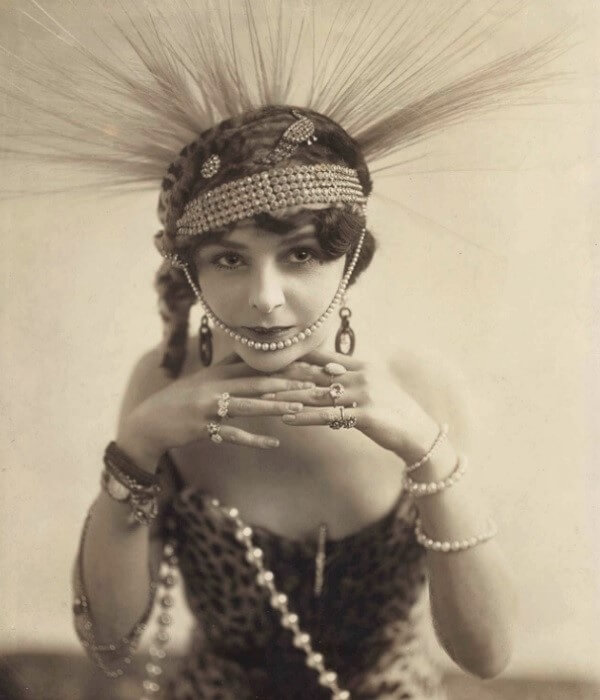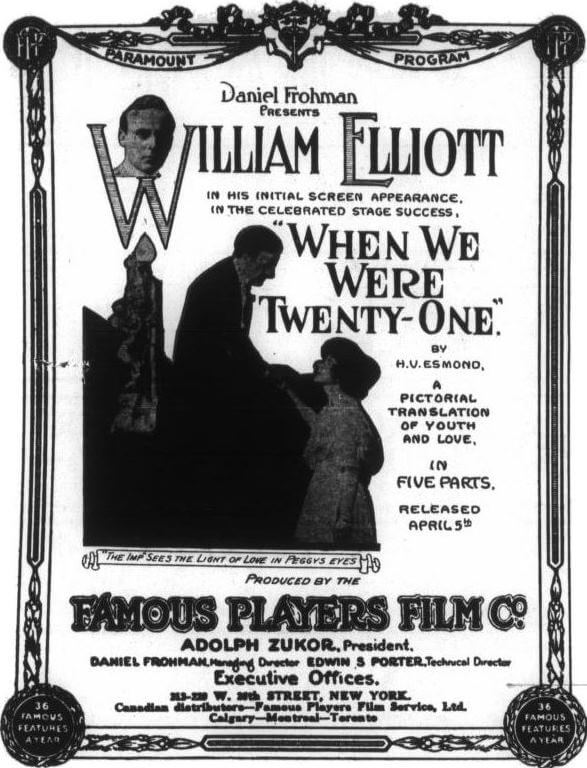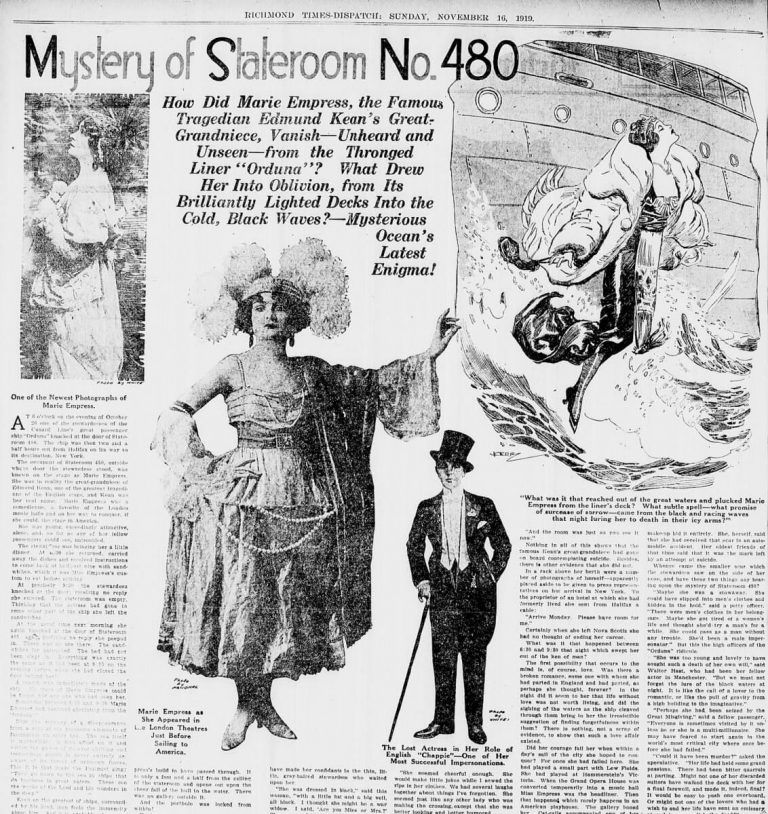Marie Empress: The Vanished Vamp
Marie Empress. Chances are great you never heard of her. But for a little while during the early days of cinema, she was a star. That is, until she mysteriously disappeared from the ocean liner she travelled on. Accident? Suicide? Murder? Or did she simply want to leave her life as a performer behind? The answer may remain forever unknown.
Miss Empress
Marie Empress was a singer, dancer, actress, comedian, and male impersonator. An acknowledged mistress of disguise, considered to be one of the most beautiful women in the western world. Now she is nearly forgotten. Her films are lost. None of her songs were recorded. Hardly anything is known about her, though that is partly due to the mystery she herself created. None of her names or backstories were real. None of her friends or family members was known. Not really, at least. There were lots of rumours about her, which she often started herself. She was said to be related to the famed Shakespearean actor Edmund Kean. She was believed to be the daughter of a former lord mayor of London and a famous French actress. She once appeared in LA newspapers as Miss Marie E. Keene, a British heiress stranded in America. And so on.
In short, the performer was incredibly talented at fooling the public and gaining publicity. As a matter of fact, she was so good at it that everyone thought her disappearance in 1919 was staged. Even when officials deemed her lost at sea, the public believed she would reappear sooner or later.
But along came the roaring twenties and the world moved on. On to forget the war and the wartime period. On to better quality films, to jazz, to flappers. By the time it was clear Marie Empress would not return, no one cared anymore.
The Early Days: Vaudeville
The earliest record of Marie’s career is traced back to 1907 when the Englishwoman was performing in South Africa. As a British colony, the country was a popular location for western performers. By 1908 the 24-year-old was back in London. Publications of that time reveal that she already was an established vaudeville actress. Another year later she left for America, where her arrival was highly advertised by her manager and theatre owner Henry Benjamin Harris, stressing the petite Marie’s good looks. The publicity campaign was so successful, other theatre owners falsely claimed the performer would also appear in their venues.
Her shows at Young’s Pier Theatre in Atlantic City seemed to have gone well since she was later scheduled to play at the larger and more established Hammerstein Victoria Theatre in New York. Alas, the promotion machine had raised expectations too high. The performance was a flop.
Marie shortly returned to England but came back to live at Long Beach for two years. She competed in numerous dog shows with her award-winning small canines. Meanwhile, in 1911, her manager Ben Harris opened the Folies Bergere, a high-class cabaret in New York. It is possible our star appeared there under another name. After all, she could sing, dance and was a talented impersonator. She was also fluent in French and may have been presented as a “French import”, faking the accent. The cabaret, too small to turn a profit, did not last a year.
Further Career
In short, Marie’s American vaudeville career was disappointing. In 1913 she tried a new, not unsuccessful path: musical theatre. Her roles were noticed but small and about two years and two musicals later the ambitious lady once again turned to a new adventure. Motion pictures.
By then, the movie industry had become a more popular source of entertainment than live theatre. Marie was talented and beautiful, had gotten good press, was great in self-promotion and had lots of connections. It was not difficult for her to make a start in the business. The first film she appeared in was the comedy Old Dutch (1915). She got good but few reviews by playing the villainess Mildred Bennett.
It was her next film When We Were Twenty One (1915) that would make Marie a star. She played the immoral burlesque dancer Kara Glynesk, nicknamed The Firefly, a typical vamp role popular at the time. In Kansas, censors banned the film because of a sensual dance she performed in it. The ban almost caused riots under a gathered crowd that wanted to see the movie. From then the actress was promoted as “The Great Vampire”, “The Sublime Vampire”, or more often, “The Sublime Vampire Woman”. Even if she didn’t play a vamp in the picture she appeared in. Marie would make at least twelve films in two years and quickly rose to stardom.
After reaching fame on both sides of the Atlantic, our now leading lady went back to her native England. It was October 1917; America was at war with Germany and Marie had just finished the performances of her new vaudeville show. She remained in England for two years but felt the urge to resume her film career. On October 19th, 1919 she boarded the ocean liner Orduna, set for New York. It would be her last journey.
Or would it?
The Disappearance
The trip across the Atlantic Ocean was entirely uneventful. Marie dressed in black from head to toe, as if she was in mourning. She was often seen wearing a monocle. “She seemed just like any other lady who was making the crossing,” said a stewardess, “except that she was better looking and better humoured.” On Saturday, October 25th the Orduna docked in Halifax, where the actress went ashore to wire a message to a New York Hotel: “Arrive Monday. Please have room for me.” Later that evening she disappeared without a trace.
There are two accounts of the night the renowned Englishwoman vanished. Steward Samuel Furnell delivered the first, telling the New York Tribune that Marie called him around 6:30 p.m. that evening, asking for a glass of water. She was in the habit of eating some sandwiches and drinking tea around 10:30 p.m. but did not ring for any that night. Samuel knocked at her door the next morning at 10:00 a.m. The performer was not in her cabin and her bed was undisturbed. When she did not turn up for lunch, a search was started.
A couple of weeks after the disappearance, a second, rather sensational account was published in newspapers across America, entitled The Mystery of Stateroom 480 (Marie’s cabin). An unnamed stewardess, probably Margaret Farley, is used as a witness in this piece. The elderly woman said she had many talks with Marie during the trip. In one of them, her passenger claimed that she may get married soon. In another, she confessed to being nervous about going to New York, stating that she did not have any friends there and was unsure where to stay. Margaret also noticed a red line running straight across the side of her nose. Marie said she had been in an automobile accident and was going to a NY hospital to treat the injury.
At 6 p.m. on the 25th the attendant asked the actress if she wanted something to eat. Marie refused at first, claiming to not feel well, but later ate some chicken. She also wanted sandwiches that night. Margaret turned her bed down and left. When she arrived with the sandwiches at 9:30 p.m., the agreed time, her passenger was not there. The stewardess left the sandwiches at the door. The next morning, she found the food uneaten and the bed unslept in. Margaret was concerned and went to the captain, who immediately ordered a search.
The two accounts slightly contradict each other. It is not clear who discovered Marie Empress missing, but the fact remains that by noon on October 26th the captain had ordered three bow-to-stern searches for the missing celebrity. Not a single clue was found.
Wireless telegraphs were sent to port authorities and the British Consul General. When the Orduna arrived, Marie’s luggage was examined by investigators. There were a few men’s clothes, probably used for her male impersonations. Odd was the lack of any jewellery since the actress was known for her fondness of glitter. Her handbag was missing, but her passport was found. It was issued to a Miss M.A. Smith, not to Miss Marie Keane, her (supposed) real name. Officials assumed she had committed suicide by jumping into the ocean.
The Last Performance
Within hours after the ship’s arrival, newspapers reported the disappearance of the star. In the following days, more and more details were added to the story. Two weeks later, The Mystery of Stateroom 480 was published across the nation, complete with photos and a drawing of Marie casting herself into the sea. I mentioned before that it was a rather sensational article, plus it contained mistakes. It said nothing about her successful American career and the author seemed to believe Marie had not taken the trip over the Atlantic since 1910. The piece gave several reasons for her presumed suicide, from drug addiction to being abandoned by a lover.
But did she really take her own life? There were plenty of other theories, like Marie being murdered by a jewel thief or a jealous lover. Or maybe she went out to get some fresh air and accidentally fell over the rail? Or did she vanish on purpose?
No one really believed – or seemed willing to believe – Marie Empress killed herself. She was in high spirits during her voyage over the Atlantic, wired to reserve a hotel room, and had publicity photos in her room to distribute to waiting reporters. The well-lighted decks of the ship were busy the evening she disappeared, and she was a strikingly beautiful lady. Someone would have noticed her if she so much as left her room.
There were various plausible theories about how the Englishwoman may have faked her disappearance. Or – as some believed – even faked her presence on the Orduna. Speculations were that Marie paid a look-alike to take her place. Indeed, she did wear mourning clothes that covered almost her entire body, the veil often hiding her face. The stars’ height on the log lists of the ship was four to six inches taller than on previous manifests. There was the red line on her nose and the mention that she did not have any friends in New York – whilst she had lived there. The look-alike theory would also explain why the name on her passport said, M.A. Smith. There were several other oddities and whilst perhaps a crazy theory, not impossible.
Marie Empress was a highly creative self-promoter and since she had been out of rotation for some years, coming back with a bang would be a great way to generate publicity. So everyone expected her to reappear soon with some kind of survival story. Some reporters even angrily asked for repercussions as soon as she came back, to punish her for the hoax.
But she never came back. What went wrong?
Maybe everything went precisely right. The actress had grown tired of being Marie Empress and wanted a new life. She vanished on purpose to be thought of as lost. Or she initially wanted to return but read some articles of cross journalists demanding punishment and decided it would be better to cancel her plans. In that case, there is a chance she returned to England and worked in vaudeville under another name.
I secretly hope something along those lines happened. The alternative is the hoax went horribly wrong and she somehow died. Or that there never was a hoax in the first place, she indeed jumped into the ocean or was murdered for unknown reasons.
On November 8th, 1921, the London Gazette published a legal notice stating that Mary Ann Louisa Horton, otherwise Marie Empress, had died on or since the 25th of October 1919.
Who Was She Really?
As noted earlier, there were a lot of claims about the identity of Marie Empress. She was known as Marie Kean(e), Marie Keen(e), Marie Smith, Mary Horton, maybe even other names. Did she really have an illustrious family? Connections with Masonic circles? Was she related to the rich and famous? The aristocracy? It seemed the performer was affluent, even before she went into the movies. Where did that money come from?
Marie’s origin turned out to be much more mundane than she made it appear. Author Samuel Fort found out that Marie Empress indeed was Mary Ann Louisa Taylor, born in Birmingham in 1884. She was the eldest of four. Her mother was Louisa Blews, her father John Taylor. He was a housepainter who died in 1901, leaving his family a rather large sum of money. Marie wed drape buyer William Herbert Horton a year later, but the couple quickly separated as the young woman became enchanted with the stage. At this time – as far as I am aware of – nothing more is known about the private life of this enigmatic figure.
Obviously, this article does not tell the whole story. Want to know more about Marie Empress? I highly recommend The Mysterious Miss Empress by Samuel Fort. I personally was so intrigued I decided to write this article to help bring Marie back from the forgotten.





